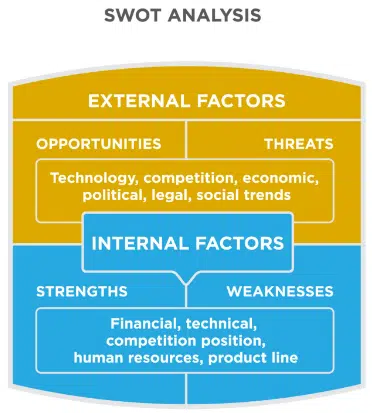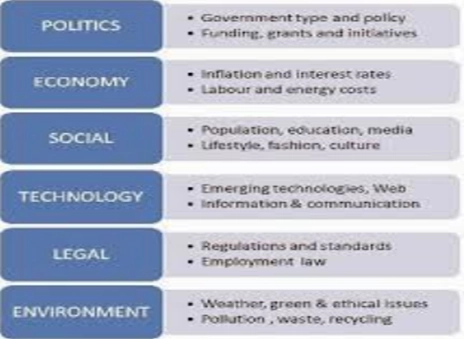Sample Undergraduate Business Assignment
Here is a sample that showcases why we are one of the world’s leading academic writing firms. This assignment was created by one of our expert academic writers and demonstrated the highest academic quality. Place your order today to achieve academic greatness.
Internal and External Business Factors
TASK 1
Internal and External Factors Influencing on Business Operations of an Organisation
Several internal and external factors can influence the business operations and success of an organisation. According to IşıK, Jones, and Sidorova (2013), the business’s internal environment comprises factors that influence operations’ approach and success. Unlike the external business environment, the organisation controls internal factors, including people, innovation, operations, marketing, resources, and finances.
SWOT Analysis for Examining Internal Factors
It is essential to recognise potential threats and opportunities outside of the organisation. However, managing internal operations and success is the key to business success. The internal factors that can influence the business operations of the organisation can be examined under SWOT analysis.
SWOT analysis, as demonstrated above, it has been identified that internal factors that can influence business operations and success of an organisation include strengths and weaknesses of the business environment that can contribute to the success or failure of the organisation. These factors are technical, financial, competition position, product line, and human resources. These factors contribute to the strengths and weaknesses of the organisation and affect its success and business operations.
For example, suppose people of the organisation are delighted and motivated to the organisational goals and objectives. In that case, they are likely to contribute to the success and performance of the organisation. In this regard, Bryson (2018) stated that the organisation’s human resources should be more vital to supporting the organisation in its business operations and attaining organisational goals and objectives.
Operational factors are a part of the administrative and operating procedures. It could influence organisational success and business operations negatively if not handled or organised properly. Innovation is also an essential internal factor that can influence organisation’s success and processes. Lack of innovation can pose a risk to the development and success of the business.
PESTLE Analysis for Examining External Factors
Technology, competition, political instability, legal, social, and economic trends are considered external factors that can influence business operations and success. It can be studied under PESTLE analysis, as mentioned in the figure below:
PESTLE analysis has identified that the business environment’s external factors are not under the control of organisation (Yüksel, 2012). These factors entail political conditions, social environment, government policies and regulations, accounting agencies, cultural environment, resources in the economy, and demographics. For example, social factors like how consumers, communities, and households behave and their beliefs.
Legal factors include how rules and legislation in society influence the business, such as changes in employment rules and laws related to working hours. Economic factors include how the economy affects a company regarding government spending, taxation, interest rates, public demand, exchange rates, and global economic factors.
Political factors are also the external factors of organisationan that can influence how government policy fluctuations might impact their business operations and success. Technological factors include how the rapid pace of innovation and product innovation and production processes affect a business.
Understanding and knowledge of the environment are substantial for the organisation to be successful and competent in the business environment.
TASK 2
Internal and External Factors affect the Running of a Business
Based on SWOT and PESTLE analysis, it has been identified that several internal and external factors of the business environment can influence the running of a salon business. According to Wu (2011), it has been estimated that the revenues would increase by £20 billion by the end of 2018. As per the pestle analysis, the following are the factors that can impact the running of the beauty salon and spa.
SWOT Analysis
Strengths
The strengths of beauty and hair salons in the UK are associated with the investments made by the company. The beauty and hair salon is spacious and has an ample rental space designated for different services. The salon offers competitive pricing, and the cosmetic product range is manufactured locally in the UK and imported.
Weaknesses
Since the company recently intends to enter the market, it will take time to establish its position and cater to growing competition. The fashion and style industry of the UK is growing at a fast pace. Hence, the salon has to work towards building its brand identity and image in the market.
Opportunities
Several fashion shows and programmes are conducted in the UK so; new beauty salons can enter the new market by launching their business in these events. Many fashion bloggers in the UK collaborate with beauty salons. Hence, this salon can also collaborate with beauty salons to create awareness among local consumers.
Threats
Based on the above analysis, it is evident that this beauty salon’s internal competencies and weaknesses may affect its operational activities through limited sales, fewer customers, and limited awareness among consumers. Therefore, the management has to play a key role in integrating effective positioning of the beauty salon in the fashion industry.
Hire an Expert Assignment Writer
Orders completed by our expert writers are
- Formally drafted in the academic style
- 100% Plagiarism-free & 100% Confidential
- Never resold
- Include unlimited free revisions
- Completed to match exact client requirements

PESTLE Analysis
Political
The essential requirement of a beauty salon is to import beauty products such as cosmetics and skincare items from foreign countries; therefore, if trade relations are favourable, salon owners can easily import products from foreign countries. With the integration of new business in the market, the external factors are likely to affect policies and regulations that the salon will be bind to follow.
Economic
Globalisation is a significant factor affecting beauty salons’ operational activities because the change in technology and demand for high-end cosmetic products has forced beauty salons to integrate foreign products into their use. Moreover, inflation is another reason which may affect the management to change its pricing structure.
Social
The primary cause of the shift in demand is a change in lifestyle and awareness about skincare products. The beauty salon management is affected directly by social factors because customers demand using new skincare products. Therefore, they have to import or either arrange their cosmetic range.
Technological
The change of customers’ perception to use new advanced techniques for clear skin pressurise the management to acquire the. Moreover, since the latest beauty salon intends to launch its skincare products; hence, the development of a cosmetic range requires a research and development department and a separate unit for manufacturing it.
Environmental
The most common threat to beauty salons is the use of chemical-based products. Hence, environmental concerns are significant to consider. The cosmetic products should be environmentally friendly when disposed of.
Legal
Before starting a new beauty salon, the management must ensure that all legal policies and guidelines are followed and implanted. The growing concern is related to importing foreign cosmetic and skincare products, for which management has to incur extra tariffs.
TASK 3
Market Forces and Consumer’s Perceptions in Skin and Beauty Care Industry
Within the past decade, the salon industry has experienced unprecedented growth. Several locations have amplified by an average of 20% yearly over the past ten years. The number of salon locations has also been increased since 2010. Growth and development in new facilities have recently increased in 2011 when numerous facilities developed by 20.96%.
In 2011, the growth rate was reduced to 13.11%, where it became stabilised due to the current lower disposable income and macroeconomic environment (Wu, 2011). In addition, in today’s economy, customers are constantly looking for value and quality in the product and services. Conventionally, salon prices have been increased at rates less than the overall inflation rate.
As per the industry analysts, 2010 has been marked as the first year in which prices for makeup, haircut, and other personal care services outpaced the overall inflation rate.
Furthermore, this industry’s existing organisations are emphasising either only on marketing or low pricing strategy. They are becoming unsuccessful in placing their products and services in the competitive marketplace. In contrast, individuals aware of the value and benefits of quality products and services are demanding for this industry’s annual growth, which exhibits more significant opportunities for the new competitors in the industry.
Thus, there is an important opportunity for beauty salons and spas to establish their business in the fashion industry by providing high-quality services and products to the customers to acquire a significant market share in this industry.
As Kapferer (2012) stated, customer perception regarding product and brand name in the beauty salon industry has high importance. It can influence business operations and the success of the business running of beauty products and services. Regarding this, Beauty salons and spas need to establish and extend business operations upon procedures and sell various beauty products. They should provide quality cosmetic products, hair products, and skin and nail care products.
Moreover, the products should include skincare products, cosmetics, conditioners, shampoos, mousse, hair spray, nail polish, lipsticks, cleansers, skin conditioners, facial masks, facial products, and other certain beauty products. What will set beauty salons apart from other competitors is their commitment to providing all of these products in one convenient location. Furthermore, their products will include all the cosmetic and hair treatments needed for both men and women for beauty services.
Customers are highly focused on quality products and services in a beauty salon and spa and desire relaxation and quality services accompanying personal beautifying and complimenting products. They are also focused on high-quality beauty services through which they can groom their personality and desire convenience and accessibility to beauty products and services. Training and consultations are also be selected by the customers on all products and services.
Despite several competitors, beauty salons and spas should be among the leading beauty salons because the other beauty salons provide beauty products and services or bridal makeovers and services. In this regard, beauty salons and spas need to initially examine the demands and requirements of potential clients and provide appropriate beauty products and services and hair treatment and services to be competitive among other competitors within the marketplace.
References
Bryson, J.M., 2018. Strategic planning for public and nonprofit organisations: A guide to strengthening and sustaining organisational achievement. John Wiley & Sons.
Demil, B. and Lecocq, X., 2010. Business model evolution: in search of dynamic consistency. Long-range planning, 43(2-3), pp.227-246.
IşıK, Ö., Jones, M.C. and Sidorova, A., 2013. Business intelligence success: The roles of BI capabilities and decision environments. Information & Management, 50(1), pp.13-23.
Kapferer, J.N., 2012. The new strategic brand management: Advanced insights and strategic thinking. Kogan page publishers.
Wu, L.W., 2011. Beyond satisfaction: The relative importance of locational convenience, interpersonal relationships, and commitment across service types. Managing Service Quality: An International Journal, 21(3), pp.240-263.
Frequently Asked Questions
To write an undergraduate assignment:
- Understand the task and guidelines.
- Conduct research on the topic.
- Plan and outline your content.
- Write a clear introduction, body, and conclusion.
- Cite sources properly.
- Edit and proofread for quality.







